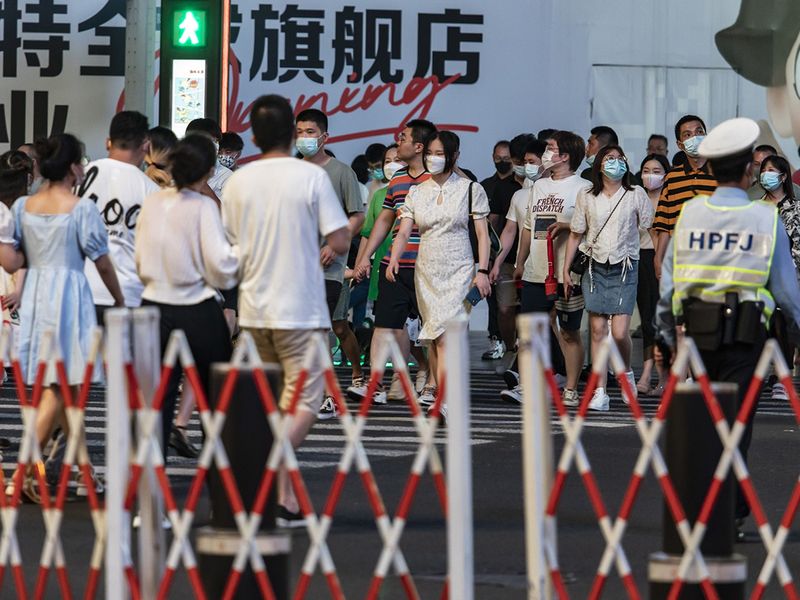
China's economy grew at the slowest pace since the country was first hit by the coronavirus outbreak two years ago, underlining the impact the pandemic and Beijing's strict approach to controlling it has had on growth. The 0.4 per cent expansion in GDP reported for the second quarter was lower than economists' forecasts of 1.2 per cent growth and the weakest pace since 2020.
That means Beijing will likely miss its goal of about 5.5 per cent growth for the full year by a wide margin, and adds another blow to a global economy hit by recession fears. Official data showed the economy improved in June as coronavirus cases fell and the government cut taxes and accelerated infrastructure spending. However, President Xi Jinping remains committed to his ‘Covid Zero’ approach to stamping out infections and some cities have recently seen cases of the highly-infectious BA.5 sub-variant, suggesting more lockdowns could occur.
"The GDP growth is a big miss," Wei Yao, chief Asia-Pacific economist at Societe Generale SA, said. "This number basically means this year's 5.5 per cent growth is out of the water, 4 per cent is still very challenging," The economy would need "a very, very strong recovery in the second half to hit 4 per cent for this year," she said.

Property stresses
Making matters worse, the data showed no sign of improvement in the slump in China's property sector investment, which drives demand for goods and services worth about 20 per cent of China's GDP. Banks have been rattled this week by reports that households in dozens of cities have stopped paying mortgages due to property developers' failure to complete construction of their homes.
"The foundation for sustained economic recovery is not stable," as the impact of domestic Covid outbreaks "hasn't been eliminated entirely," the National Bureau of Statistics said. It warned of "rising stagflation risks" in the world economy, tightening of monetary policies in major economies and the impact of domestic virus outbreaks.
“China's 2Q GDP expansion showed the economy's resilience and the impact of powerful policy stimulus - but the durability of the recovery remains in doubt,” said Chang Shu and David Qu, Bloomberg analysts said. “We are encouraged by the evenness of the rebound in June activity, with both manufacturing and service sectors climbing.
“But consumption is at risk yet again, given the virus outbreaks in July. In the near term, the government is likely to keep rolling out stimulus to support the recovery.”
4% is doable
Economists expect China's GDP to expand just over 4 per cent this year, with outlook for the remainder of the year fairly uncertain. "The magnitude of the slowdown was larger than expected," said Liu Peiqian, chief China economist at NatWest Group.
"But clearly there are more headwinds facing the recovery in the second-half including the sluggish domestic demand recovery, slowing external demand and challenging property sector outlook."
Friday's data showed consumption began improving in June after financial and trade hub Shanghai emerged from its crippling lockdown that began in March and restrictions in several other cities were eased as cases of coronavirus fell. The heavy toll of Shanghai's lockdown was clear from the data: the city's economy contracted 13.7 Chang Shu and David Qu in the second quarter from a year earlier.
A shrinking second quarter
Although official data showed an expansion in GDP, several high-frequency indicators suggest activity actually shrank in the quarter. Travel data showed passenger trips taken on China's roads were mostly below last year's levels into July, while car purchases, which make up about 10 per cent of monthly retail sales, fell more than 10 per cent in the quarter.

Despite growing pressures, the People's Bank of China has taken a cautious easing path this year, refraining from cutting policy rates since January. Earlier Friday, it refrained from injecting fresh funds into the banking system and kept the rate on its one-year policy loans unchanged at 2.85 per cent.
Infrastructure focus
Beijing has been beefing up infrastructure spending to help offset the slump in growth. The government and policy banks are making 7.2 trillion yuan ($1.1 trillion) available for projects, according to calculations from Bloomberg News.
"We are seeing that the Fed is hiking rates at a very aggressive way," Betty Wang, senior economist at Australia and New Zealand Banking Group Ltd., said on Bloomberg Television. "So that's why we think that from policymakers' perspective, especially on monetary policy, this is not a good chance for China to cut the monetary policy rate."








